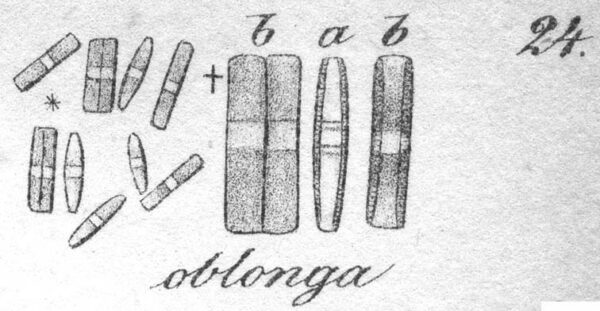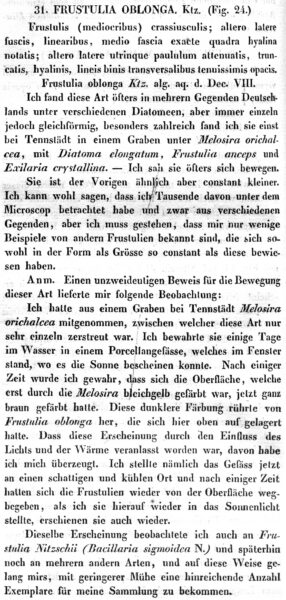Navicula oblonga
-
Category
-
Length Range86-176 µm
-
Width Range15-19 µm
-
Striae in 10 µm7-9
-
SynonymsPinnularia oblonga (Kütz.) W.Sm. 1853
-
ContributorLoren Bahls - Nov 2011
-
ReviewerMarina Potapova - Nov 2011
Identification
Description
Valves are linear to linear-lanceolate with very broad, rounded apices. The axial area is linear and about twice the width of the raphe. The central area is more or less orbicular and 2-3 times wider than the axial area. The raphe is lateral, becoming filiform near the proximal ends, which are simple and deflected slightly toward the secondary side. The secondary side is typically marked by prominent Voigt discontinuities. Striae are radiate and finely lineate. Near the valve apices the striae are convergent along the valve margins, but they are bent and are radiate along the axial area. Striae are irregularly shortened about the central area, where very short striae may not reach the valve margins. Areolae number 32-40 in 10 µm and are distinguishable in LM with critical illumination.
Autecology
Navicula oblonga is widely distributed in lakes, ponds, and streams in the plains, mountains, and intermountain basin regions of the Northwest, as well as elsewhere in the U.S. (Patrick and Reimer 1966). Navicula oblonga prefers alkaline fresh waters with elevated concentrations of dissolved solids and nutrients (see table below).
Common diatom associates of Navicula oblonga in the Northwest include Gomphonema brebissonii, Stauroneis gracilis, Fragilaria capucina v. mesolepta, Staurosira reimeri, Epithemia argus, Synedra delicatissima, Craticula cuspidata, Cymbella aspera, Navicula libonensis, Nitzschia radicula, Cymbopleura inaequalis, Pseudostaurosira elliptica, Mastogloia elliptica, and Fragilaria famelica.
-
Size Range, µm3
-
Motility
-
Attachment
-
Habitat
-
Colony
-
Occurrence
-
BCG
-
Waterbody
-
Distribution
- Learn more about this
Original Description
Frustulis (mediocribus) crassiusculis; altero latere fuscis, linearibus, medio fascia exacte quadra hyalina notatis; altero latere utrinque paululum attenuatis, truncatis, hyalinis, lineis binis transversalibus tenuissimis opacis. Frustulia oblonga Ktz. alg. aq. d. Dec. VIII. Ich fand diese Art öfters in mehrern Gegenden Deutschlands miter verschiedenen Diatomeen, aber immer einzeln jedoch gleichförmig, besonders zahlreich fand ich sie einst bei Tennstädt in einem Graben unter Melosira orichalcea, mit Diatoma elongatum, Frustulia anceps und Exilaria crystallina. — Ich sah sie öfters sich bewegen. Sie ist der Vorigen ähnlich aber constant kleiner. Ich kann wohl sagen, dass ich Tausende davon unter dem Microscop betrachtet babe und zwar aus verschiedenen Gegenden, aber ich muss gestehen, dass mir nur wenige Beispiele von andern Frustulien bekannt sind, die sich sowohl in der Form als Grösse so constant als diese bewiesen haben. Anm. Einen unzweideutigen Beweis für die Bewegung dieser Art lieferte mir folgende Beobachtung: Ich haute aus einem Graben bei Tennstädt Melosira orichalcea mitgenommen, zwischen welcher diese Art nur sehr einzeln zerstreut war. Ich bewahrte sie einige Tage im Wasser in einem Porcellangefässe, welches im Fenster stand, wo es die Sonne bescheinen konnte. Nach einiger Zeit wurde ich gewahr, dass sich die Oberfläche, welche erst durch die Melosira bleichgelb gefärbt war, jetzt ganz braun gefärbt hatte. Diese dunklere Färbung rührle von Frustulia oblonga her, die sich hier oben auf gelagert hatte. Dass diese Erscheinung durch den Einfluss des Lichts und der Wärme veranlasst worden war, davon habe ich mich überzeugt. Ich stellte nämlich das Gefäss jetzt an einen schattigen und kühlen Ort und nach einiger Zeit hatten sich die Frustulien wieder von der Oberfläche wegbegeben, als ich sie hierauf wieder in das Sonnenlicht stellte, erschienen sie auch wieder. Dieselbe Erscheinung beobachtete ich auch an Frustulia Nitzschii (Bacillaria sigmoidea N.) und späterhin noch an mehrern andern Arten, und auf diese Weise gelang mirs, mit geringerer Mühe eine hinreichende Anzahl Exemplare für meine Sammlung zu bekommen.
-
BasionymFrustulia oblonga
-
AuthorKütz. 1833
Citations & Links
Citations
Links
-
Index Nominum Algarum
-
GenBank
-
North American Diatom Ecological DatabaseNADED ID: 46832
Cite This Page
Bahls, L. (2011). Navicula oblonga. In Diatoms of North America. Retrieved July 26, 2024, from https://diatoms.org/species/navicula_oblonga
Responses
The 15 response plots show an environmental variable (x axis) against the relative abundance (y axis) of Navicula oblonga from all the stream reaches where it was present. Note that the relative abundance scale is the same on each plot. Explanation of each environmental variable and units are as follows:
ELEVATION = stream reach elevation (meters)
STRAHLER = distribution plot of the Strahler Stream Order
SLOPE = stream reach gradient (degrees)
W1_HALL = an index that is a measure of streamside (riparian) human activity that ranges from 0 - 10, with a value of 0 indicating of minimal disturbance to a value of 10 indicating severe disturbance.
PHSTVL = pH measured in a sealed syringe sample (pH units)
log_COND = log concentration of specific conductivity (µS/cm)
log_PTL = log concentration of total phosphorus (µg/L)
log_NO3 = log concentration of nitrate (µeq/L)
log_DOC = log concentration of dissolved organic carbon (mg/L)
log_SIO2 = log concentration of silicon (mg/L)
log_NA = log concentration of sodium (µeq/L)
log_HCO3 = log concentration of the bicarbonate ion (µeq/L)
EMBED = percent of the stream substrate that is embedded by sand and fine sediment
log_TURBIDITY = log of turbidity, a measure of cloudiness of water, in nephelometric turbidity units (NTU).
DISTOT = an index of total human disturbance in the watershed that ranges from 1 - 100, with a value of 0 indicating of minimal disturbance to a value of 100 indicating severe disturbance.

Navicula oblonga
- Large linear valves
- Terminal striae bent
- Central striae do not reach valve margin
- Proximal raphe ends simple
- Striae finely lineate
The large valves of Navicula oblonga are linear and lack protracted ends. Although terminal striae are convergent at the margins, they are bent back toward the central area and are radiate next to the axial area. Short central striae often do not reach the valve margins. Proximal raphe ends are simple and barely wider than the raphe....
 Diatoms of North America
Diatoms of North America








